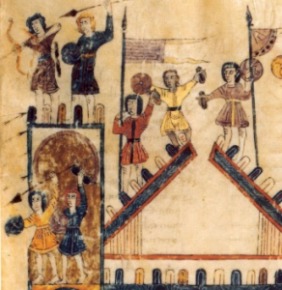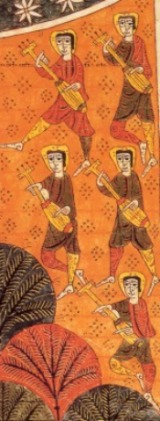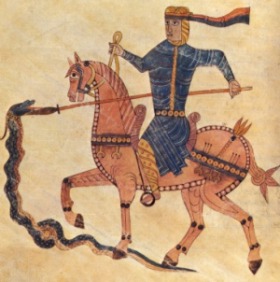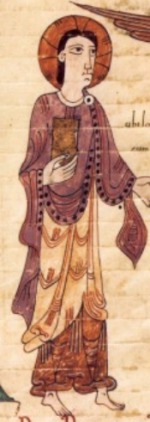The basic garment of the Visigoths, like
the Romans, was the tunica (tunic) with sleeves. There are several
types described: the tnica pectoralis (a short tunic), the tunica
escarlate and the tnica coccina (red tunics), and the armilausa
vulgo. The armilausa was foreign to the Roman tradition,
as it was open in front and behind some of these had an open skirt with
sharp points and are seen in Visigothic reliefs in Asturias. There is
also mention of a woman's tunic called an amiculum, which was
worn by women of questionable repute in Rome, but was worn in Spain by
honest women.
Gerona Beatus,
Gerona Cathedral 7, fol.242
Still in evidence in the Roman tunic, decorated with
vertical strips called clavii. Tunics were frequently decorated
with bold stripes, both horizontal and vertical, and were belted with
a thick, buckled belt known as a cingulum, many of which have
been found in burial excavations.
There is also an unusual style seen in
the Codex Armilianensis, a Visigothic manuscript. Here we see,
on both men and women, what appears to be a long tunic or gown with tiers
of flounces. Boucher speculates that these were introduced into Spain
by merchants from Syria, where this type of Cretan-inspired skirt was
worn.

Codex Aemilianensis Ms.d.1.1. (A.D.976)
Beatus., London, British Library, Add. 11695, fol.164 A.D. 1109
Valladolid Beatus, Valladolid,
B. U., 433, fol. 148v
Gerona Beatus,
Gerona Cathedral 7, fol.70v.
Men (and possibly women) wore various kinds
of leg coverings, similar to modern-day pants. Bracae were brief,
and only covered the intimate parts, while femoralia were longer
and also covered the thighs. Tubrucos, a name that today designates
pants, were worn either tight or loose around the ankles. These are shown
in Roman reliefs as barbaric dress, and Bernis notes that they bear a
strong resemblance to pants worn by the Parthians in the Persian Empire.
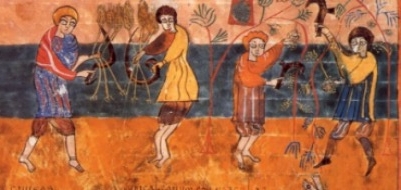
Left: Valladolid Beatus, Valladolid,
B. U., 433, fol. 148v
B. U., 433, fol. 148v
Turning our attention from the bottom to
the top, it is seen that the short hair worn in the classical Roman period
was giving way to longer styles, and these new styles favored bangs to
the ears. It was the custom for young women to wear their hair loose,
signifying an unmarried state. San Isidoro also mentions a capitulare
in relation to women's headwear, but we can only surmise what this could
be.

